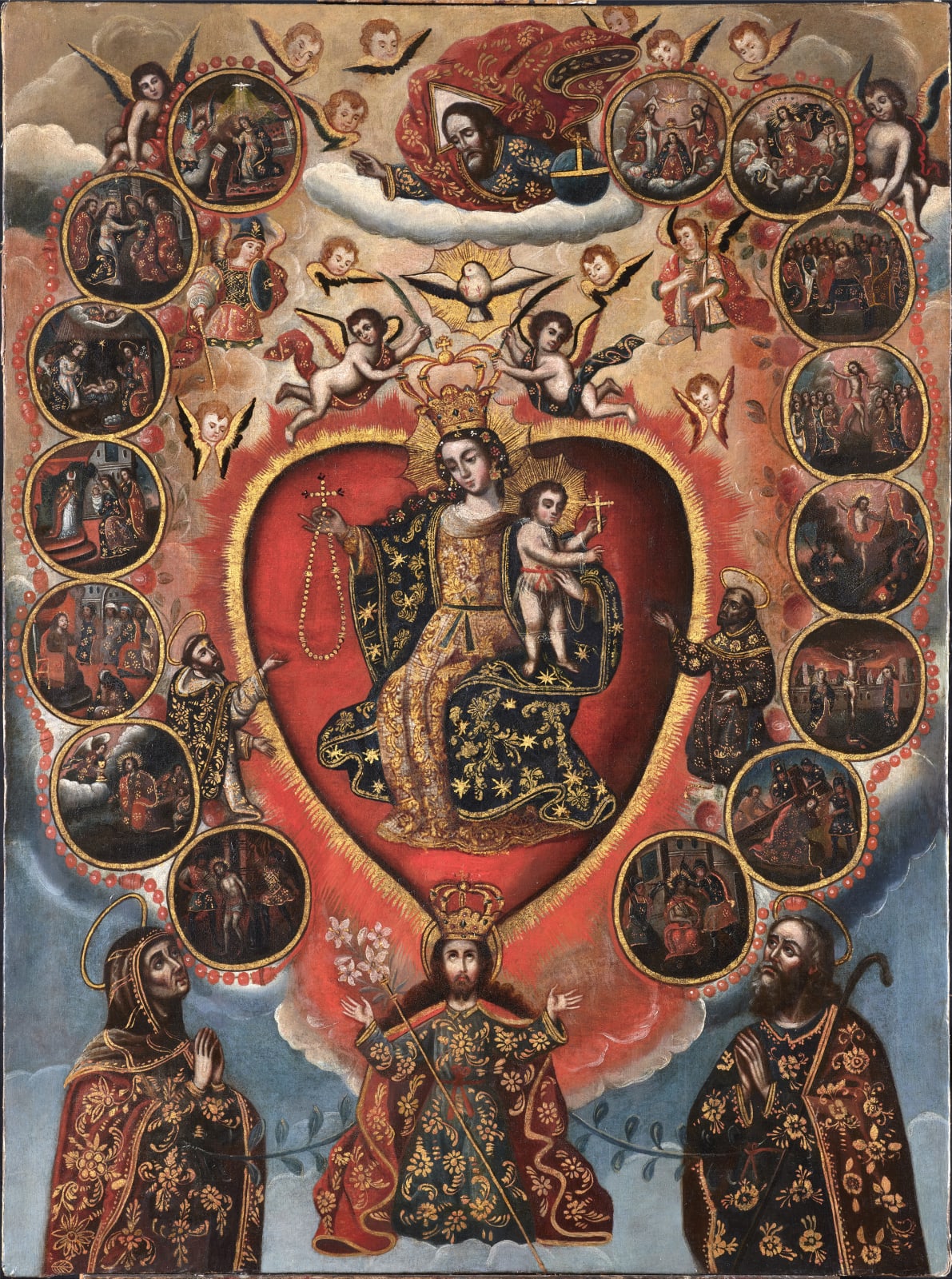GASPAR MIGUEL DE BERRÍO (ATTRIB.)
Our Lady of the rosary, (Puna, upper Peru), 1705 - 1762
Oil on canvas.
90.5 x 67.5 cm.
Provenance
Private Collection
Caspar Miguel de Berrío was, without doubt, one of the most iconic painters of the Bolivian High Plateau. A Criollo by birth, and native to the Puna region, in the...
Caspar Miguel de Berrío was, without doubt, one of the most iconic painters of the Bolivian High Plateau. A Criollo by birth, and native to the Puna region, in the area surrounding the Imperial City of Potosí, he was born in around 1706. It was in this major economic hub that he would undertake his artistic activity between 1735 and 1762, attaining the title of master painter and leading the school of Pérez de Holguín.
The main group of works produced by Master Berrío is currently to be found in the Museo Casa de la Moneda in Potosí. Others are housed in the Museo Nacional de Arte in La Paz, in the Museo Colonial de Charcas in Sucre, in the Museo Isaac Fernández Blanco in Buenos Aires and in the Philadelphia Art Museum.
During his almost 30-year career, he carnt the recognition of his peers and of viceregal high society, becoming the most outstanding painter in the generation of disciples and followers left by Melchor Pérez de Holguín, eclipsing other talents such as Joaquín Caraballo, Nicolas de los Ecoz, Manuel de Córdoba and Nicolás Cruz, who showed their skills faithfully following the models of their Master.
In contrast to the abovementioned artists, Berrio limited himself to adopting certain characteristic features of Holguin, such as his way of depicting ashen faces, with pointed noses and elongated hands, while infusing his works with his own style.
It is worth highlighting the fine detail, realism and creative genius of his work. Logically, and as would be the case in other key points in the Peruvian Viceroyalty with other pioneers of schools, the influence of the Cuzco style would be essential for the creation of a regional art that would become impregnated with its own elements and style, as is the case with this Potosí school, which was born with Holguín and would continue to grow with Berrio as its greatest exponent. This influence from Cuzco is clearly seen in the subjects depicted, in the use of space and the abundant gold brocateado.
The abovementioned characteristics may be observed in the work we are addressing here, a worthy example of Latin American Baroque, placing the Virgin Mary at the center, depicted by the Sacred Heart of Christ. The first thing one notices in this work is the large number of figures crowding the scene and its compositional originality.
The location allocated to cach figure, symbol or secondary scene was by no means left to chance in this complex composition. This points to a profound knowledge of Christian dogma as befitting an artist experienced in religious subjects. As is also the case in the Patronage of St. Joseph, in the Coronation of the Virgin and in numerous works by our artist, the figures are located within the painting according to their varying degrees of prominence.
In the work we are presenting here, the scene is set against a light skyblue background which melts into the clouds. The center is dominated by the Sacred Heart of Christ, which contains the Virgin and the Infant Jesus. The Virgin is holding a rosary and being crowned by two little angels, while wearing exquisite robes with gilt brocade imitating stars and plant motifs. Her long head of hair is adorned with brightlycolored flowers and she boasts beautiful gold earrings. Sat on an imaginary throne, she offers the rosary to St. Dominic, on his knees below her, while cradling the Infant Jesus in her left arm, the latter standing on her skirts, dressed in a smooth, transparent silk cloth. The Infant, carrying a cross, is blessing St. Francis, who is kneeling at the same level as St. Dominic. Oddly, the Holy Trinity is depicted vertically in the center of the painting, made up of God the Father (emerging from a cloud and with a triangular halo symbolizing his three-fold presence), the Holy Spirit (in the form of a white dove) and the crowned Jesus Christ, depicted underneath his mother.
On each side of the Savior, and bound to him by a sort of branch, are St. Anne on the left and St. Joachim on the right. In the upper section, a number of cherubim are seen fluttering around, interacting with the archangels St. Michael and St. Raphael. The Virgin is framed by 15 golden hoops, inside each of which scenes from her life and that of her son Jesus Christ are depicted.



